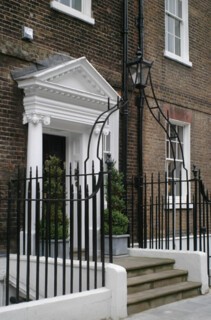Something untoward has happened in our block of flats. Up on the sixth floor a door has been staved in. It has been made safe with a pair of new padlocks and much of the splintered wood has been covered with corrugated iron. The reason could be as simple as a malfunctioning lock, or as sad as the woman who lives there not answering calls. It can’t have been a break-in. The noticeboard downstairs that keeps us up to date with such things – the drug dealers who seem to have been using our bin store, the occasional intrusion of a burglar – would have given details and told us, once again, to check that the front door is shut properly at all times and not to let in strangers.
The front door is a flat’s or a building’s mouth; to see it smashed open, its power to let in and keep out challenged, makes for anxiety. The affront goes deep. Doors are symbolic as well as functional. When council flats were sold off in large numbers in the 1980s you could follow the progress of privatisation by casting an eye over a block and noting which of the original, plain doors had been replaced. Newly empowered owners used panelled hardwood and glazed lunettes to mark their elevation from tenant to freeholder. Even in the best-mannered of London’s enclaves the colour of a door is a personal statement. The estate – public or private – aspires to uniformity, even legislates for it. When constraint is relaxed the door is the first place where individuality breaks through.
For a couple of hundred years domestic architecture in London tended towards uniformity. Terraced houses stayed much the same for a long time, and what changes there were affected the plan rather than the elevation. Despite variations in the detail of brick and plasterwork, in the depth of window reveals and the size of windowpanes, an early 18th-century house in Meard Street or Queen Anne’s Gate, a late 18th-century house in Bedford Square and a mid-19th-century one in Gordon Square are variations on a common pattern. Their general aspect is little affected by fashion. Doors and their surrounds are different. In Queen Anne’s Gate the richly carved door hoods project far enough to offer protection from the rain; very soon that baroque decoration (the most extravagant example of it in London, two doorways capped by shell hoods, can be found in Laurence Pountney Lane, in the City) gives way to milder emphasis – a pediment, or a carved or cast keystone in the door arch. In general, doorways become less assertive, more correctly classical as a Brummell-like discretion in architectural dress overcomes more flamboyant detail. A modern flush door can seem, on this reading, an evolutionary end point.
Whether they’re emphatic or discreet, it would be odd if the doors of houses weren’t built on a human scale. Cathedral doors, even some church doors, can take up a substantial part of an end wall. When there is no ceremonial reason to open them, visitors, who enter by side doors, or even, like cats, through a small door cut into the main one, are reminded that this is the house of a being on a scale larger than their own. An open temple door is a strong metaphor; I would like to see a modern Temple of Janus, its doors closed only in times of peace, on the empty plinth in Trafalgar Square.
The door in one large but essentially ordinary-looking 18th-century front carries more symbolic weight than any other in London. A picture of a mere detail – brass numbers on black – is enough to identify 10 Downing Street. The reshuffled minister is shown the door, the door is opened to new policies when a successor waves to the cameras and passes through. Petitioners don’t exactly have it slammed in their faces, but they usually meet it closed. Eventually one prime minister’s chattels go out and a new lot comes in. Some regular visitors will never darken it again. The door to Number 10 domesticates politics because it is commonplace in its look and scale: we know what it is like to stand on such a threshold, we too do things behind closed doors.
House doors are defensive; bank doors, too, have traditionally and much more powerfully advertised their impregnability: these are buildings designed to project solidity and probity – ‘your money is safe here.’ Soane’s Bank of England was largely demolished in the 1930s, but rebuilding took place within the perimeter wall and much of it is more or less as he left it. The new door inserted within an expanded version of one of the two niches that broke the 135-metre west front – a formidable run of rusticated stonework, high and windowless – seems to expect assaults of military ferocity. But these days money flickers over electronic networks, and while bullion vans doubtless come and go you wouldn’t expect to see much if you hung around next time the Bank made billions available to commercial borrowers. These days electronic vulnerability is met by metaphorical firewalls, and a high-street bank is much like any other shop, now that it no longer has to pretend to be a strongroom.
Very few shops have doors you can’t see through. They want people to come in, so they have glass doors that often open automatically. Modern architecture, and the technology that makes lightness and transparency possible – in this sense 19th-century arcades and department stores are modern – goes well with retailing. Once people have been drawn into a big enclosed mall, store or arcade, the counters can be as open as booths in a fairground. What some modern buildings do less well than old ones is tell you where you are. The stone in, say, the portico of the British Museum is more than decoration. It is a sign – an extravagant one – that leads you to the door. Your progress becomes ceremonial. The Barbican offers few clues of that kind and is notoriously hard to find your way about in. Like a passenger liner, it is easy to get lost in: you can’t stand back and orientate yourself.
One of the pleasures of walking through the streets of the older parts of French towns are the glimpses you get through doorways into courtyards. Sometimes you’re looking through small doors (cat-flaps again) let into double ones that could be opened to let in a carriage. Similar glimpses through doorways in paintings by Pieter de Hooch imply much about the world beyond by showing a little of it. Doors to walled gardens are especially tantalising. Architects have always played the game of calculated display: buildings are seen on the move, revealed in time; they aren’t, like paintings, objects of static contemplation. During the process, doorways open the way into, close off, give early, partial views of spaces and vistas. New, glass-fronted buildings that hide nothing don’t play that game. Yet even the frank display they seem to offer is a tease. Checkpoints and turnstiles lie beyond the welcomingly sliding glass. Things look more open, but high up cameras are tracking you.
Send Letters To:
The Editor
London Review of Books,
28 Little Russell Street
London, WC1A 2HN
letters@lrb.co.uk
Please include name, address, and a telephone number.


